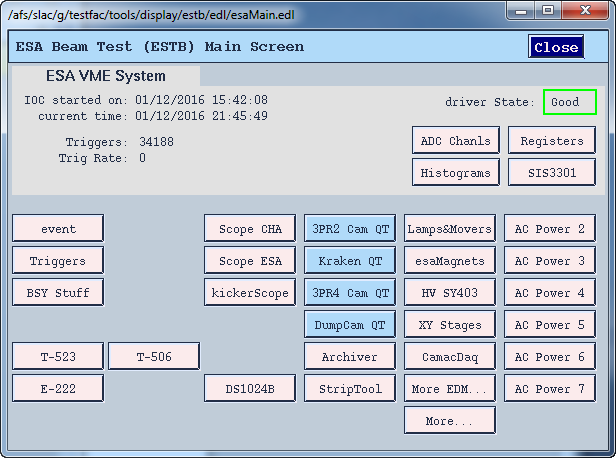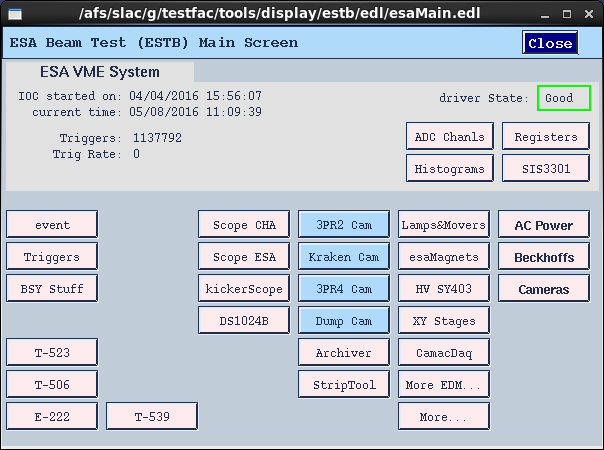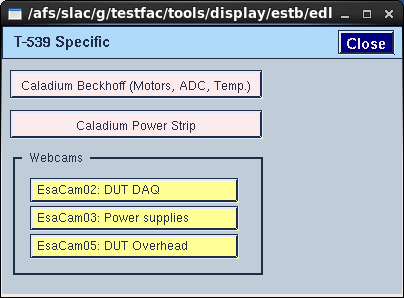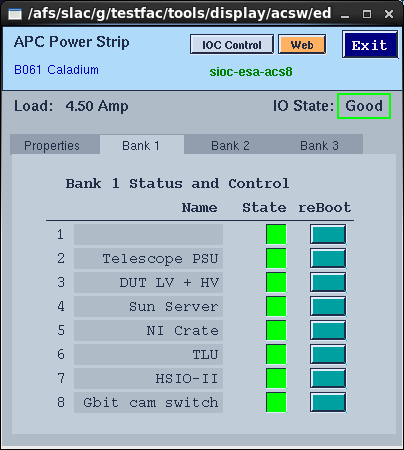...
The SLAC End Station A Test Beam (ESTB) was re-establishing in 2014 to take small fraction of SLAC LCLS beams into End Station test beam line. The operation is largely parasitic to the LCLS operations with electron beams in the 5-13 GeV range depending on the LCLS operation energy. From the FACET/ESTB portal, you can navigate to info on proposals, new user registrations, as well as ESTB schedules etc. The CALADIUM EUDET telescope owned by Carleton University has been installed at the end of ESTB as a precision tracking telescope with 6 planes of CMOS/MIMOSA sensors with ~3 micron spatial resolution. User Device Under Test (DUT) can be mounted on a movable stage in the middle of the telescope. For ATLAS pixel test beam users, a HSIO2/RCE based DUT readout will be provided as a standard readout utility.
...
- T-539 ATLAS Silicon Tracking Development (welcome shared ATLAS use)
Scheduled sessions:
The list of sessions below may be incomplete (welcome to add missing sessions). Links behind each session dates below navigates to activities on individual sessions.
...
The Caladium telescope control and DAQ is handled by the National Instrument (NI) crate which collects data via the TLU with data producers from the telescope itself and the DUT. The DUT readout is upgraded to a simpler arrangement with just the HSIO-II controlled by the ESADUTDAQ1 server node (replacing ESA-USER02) via a direct private ethernet link. Due to the very short ESTB bunches, there is no need for additional triggers within the bunch and the DAQ is simply driven by the bunch crossing beam trigger. The SWH-B061-NW01 network switch in the middle of the ESA hall support the ESA-RESTRICTED local network 172.27.104.* (port 25-48) where both the NI crate and ESADUTDAQ1 reside on. The EUDAQ console PC AR-EUDAQ in the ESA Control Room and several other nodes e.g. AR-ESAUX2 are connected to the ESATESTFAC public subnet 172.27.100.* (port 1-24) on the same switch, but can also see the local ESA-RESTRICTED subnet. The connection from the NI crate and ESADUTDAQ1 to the switch are routed through the Belgen patch panel inside the tunnel near the optical table.
...
While the DUT readout can be of variety of ways, the RCE readout setup is provided for at least ATLAS pixel users as a standard utility. As of Apr/2016, the DUT RCE readout is upgrading from old the Gen-1 RCE + HSIO setup to a simpler HSIO-II setup, with the dedicated ESADUTDAQ1 Sun server residing the beam tunnel near the EUDET area as the DUT RCE readout host. HSIO-II has the DTM mezzanine with the Gen-3 ZYNQ based RCE operating an Arch-Linux based ARMS CPU that communicates with external world via its native 1Gb/s Ethernet. More general information on HSIO-II/RCE can be found on the RCE Development Lab Twiki.
...
The ESTB EPICS control/monitoring interface that provides some important general utilities, such as the XY stage remote control to align the telescope and DUT to the beam, and remote controlled individual power strip socket on/off that can come handy for remotely powering off detectors and rebooting stuck DAQ components and computers inside ESA, as well as web cams. To access the ESTB EPIC panel:
...
(if you are using the ar-esaux3 console in the ESA control room locally, it's likely that it was already logged in as tfuser with this setup already done)
(this last command should bring up the ESTB EPICS panel on the right) |
|---|
XY Stage Beam Alignment
For ATLAS test beam operations with Caladium, the dedicated T-539 panel contains some of the most relevant sub panels. |
|---|
Beam Trigger
The "Triggers" panel on the ESTB EPICS GUI brings up the Experimental Triggers panel where channel 10 (Si Tracker Caladium) controls the beam trigger. The trigger NIM signal is carried to Caladium with a green BNC cable to a LEMO connection into the TLU Chan 0 PM in trigger port. The Delay value is the critical control of timing that DUT is very sensitive to and vary significantly between different types of DUTs, while EUDET seems to work with a wide range of delays automatically. The Trigger width parameters didn't appear to have much effect on anything.
Beam Dump Monitor
The beam dump monitors, Lead Glass (LGdump) dump, and Front/Read dumps are a key monitoring tool to give direct look at the beam intensity. ESTB GUI "Scope ESA" panels is particulary useful as a standard monitor for instantaneous beam status as scope pulses. "ADC Chanls"/"Histograms" panel displays the instantaneous values and distributions of energy measurements of various dumps. "HV SY403" can be used to adjust HV values for different intensity measurements.
The T-539 panel
| The T-539 panel contains most of the relevant displays for Caladium telescope and ATLAS DUT. | |
|---|---|
Caladium BeckhoffXY stage motors: The telescope + DUT assembly are mounted on a remote controllable base "coarse" XY |
...
control (X=horizontal transverse to beam; Y=vertical) to align the whole assembly wrt beam. During new test beam periods, this is typically done initially using a pair of alignment lasers in conjunction with fiducial markers to center to expected beamline within a few mm. The vertical position is gauged by a laser mounted on the tunnel side wall. The horizontal position is gauged by another laser hanging the ceiling near the side entrance. Once positioned close enough, the refined alignment is done with the beam data in telescope. For both laser alignment and beam alignment, the position adjustments for the whole telescope (including DUT mounted within it) is done with the dedicated |
...
Caladium XY stage Beckhoff26 subpanel shown on the right. The base XY stage for the whole telescope + DUT is controlled by the "coarse" X,Y adjustments. +X is pointing away from the ESA entrance gate; +Y is pointing up. The Spring/2016 upgrade added a "fine" XY stage for the DUT to allow additional adjustments |
...
of the DUT |
...
with respect to the telescope. There is |
...
an additional optional DUT rotational stage control. Temperature The Caladium upgrade also added some temperature sensors that can be plugged into desired parts of the DUT setup. The displays for them are on the "KL3314 temp" tab of the Beckhoff panel. |
Beam Trigger
The "Triggers" panel on the ESTB EPICS GUI brings up the Experimental Triggers panel where channel 10 (Silicon Tracker Calladium) controls the beam trigger LEMO signal going into the TLU Chan 0 PM in trigger port. The Delay value is the critical control of timing that DUT is very sensitive to, while EUDET seems to work with a wide range of delays automatically. The Trigger width parameters didn't appear to have much effect on anything.
Beam Dump Monitor
...
Remote Power Strip ControlThe new T-539 panel has a sub panel contains the individual socket controls for the dedicated power strip on the |
...
| Caladium+DUT electronics/DAQ rack. Clicking on individual channel channel's "Reboot" button will recycle power on that channel. Some channels may automatically flip the state to green after a brief moment, others may need deliberate push on the state button to reenable. The assignments of the channels for the May/2016 T-538 run is shown on the right as an example. Using the terminal in the ESA counting house logged in as tfuser anyone update the channel titles themselvles. |
Useful links
SLAC FACET/ESTB portal | ESTB portal (including beam schedule) | ESTB new user registration |
...
ESTB web cams (only within SLAC network): DUT box overhead | DAQ rack overhead | Rack power supply | DAQ rack HSIO-II | Beam dump II | Caladium+table | Counting House |
ATLAS test beam / pixel documentations: ATLAS pixel test beam Twiki | Pixel calibration manual
...




